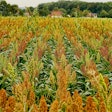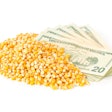
U.S. agricultural exports to Mexico have quintupled since the ink dried on the North American Free Trade Agreement (NAFTA) more than 20 years ago. And Mexico’s animal agriculture and feed manufacturing industries want to keep buying even more U.S. corn, sorghum, distiller’s dried grains with solubles (DDGS) and other products, according to a team of Mexican grain buyers, livestock and feed processing representatives who traveled to Nebraska and Washington, D.C., this week.
|
Click to USGC President and CEO Thomas Sleight discuss the Mexican grain team. |
The agribusiness industry team, organized by the U.S. Grains Council (USGC) and the National Corn Growers Association (NCGA) with support from Nebraska Corn, spoke directly with farmers in Nebraska at a roundtable on Tuesday, followed by a press conference with Nebraska Governor Pete Ricketts. The team then traveled to Washington, D.C., for meetings with the House Ways and Means Committee, House Agriculture Committee, Senate Finance Committee and Senate Committee on Agriculture, Nutrition and Forestry.
|
Mexican Grain Team with Nebraska Governor Pete Ricketts. Photo courtesy of Nebraska Corn. |
Collectively, the grain industry teams and their associations represent approximately 80 percent of the grain-buying organizations in Mexico. At every session, team members emphasized why they prefer to purchase U.S. grains as well as their concerns related to NAFTA renegotiation, the process which formally started Thursday with the Trump Administration's notification to Congress. They also heard from U.S. stakeholders about their perspectives on the coming modernization negotiations.
“NAFTA is the critical piece of trade policy underpinning past success and future development of market potential yet to be tapped in Mexico,” said Thomas Sleight, USGC president and CEO. “This mutually beneficial scenario for U.S. farmers and Mexican producers is built on a strong trading relationship underpinned by advantageous trade policy and robust market development.”
Thanks to the favorable terms in NAFTA, increasingly integrated logistics and close geographic proximity, Mexico is the largest export market for U.S. corn. Mexico purchased 524.4 million bushels (13.3 million metric tons) worth $2.5 billion last marketing year, in addition to 23.86 million bushels (606,127 tons) of sorghum and 1.9 million tons of DDGS.
“These buyers shared that, although nothing has formally changed with the NAFTA agreement yet, Mexican markets and political dynamics have already been impacted,” said Jon Doggett, NCGA executive vice president and head of public policy. “Without duty-free trade, they told us corn from the United States would not even be an option, even though our corn is what they want to buy.”
|
Click here to view a larger version of this chart. |
Mexican buyers, like those represented on this team, welcome imports from the United States because U.S. feed grains provide a reliable supply of valuable nutrition for Mexico’s growing livestock, dairy and poultry sectors. USGC’s work in Mexico over the last 30 years has helped these businesses expand their operations, while also expanding the use of U.S. grain products throughout Mexico.
“Mexico’s animal producers are progressive, and they are growing,” said Ryan LeGrand, USGC director in Mexico, who accompanied the team traveling in the United States. “This means more production in Mexico and more need for grains - which should be U.S. grains as long as we keep NAFTA in place.”
Watch the team’s press conference in Nebraska here. Learn more about USGC’s work in Mexico here.


















